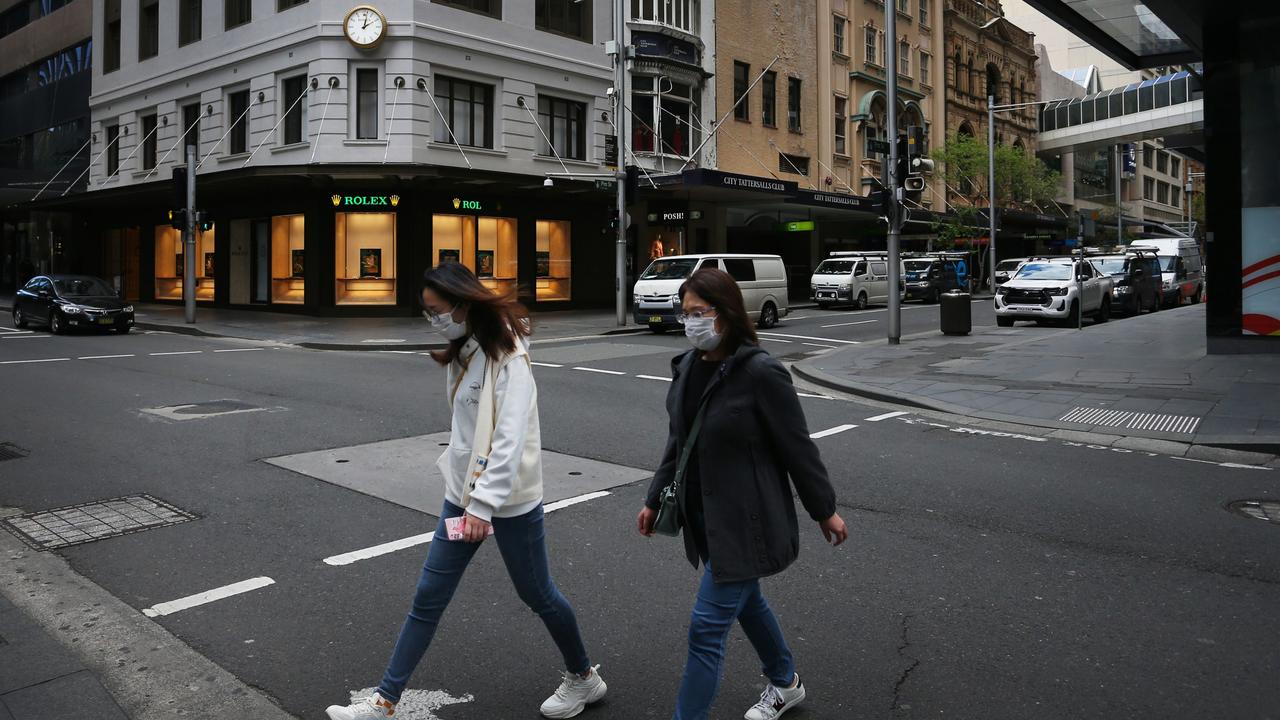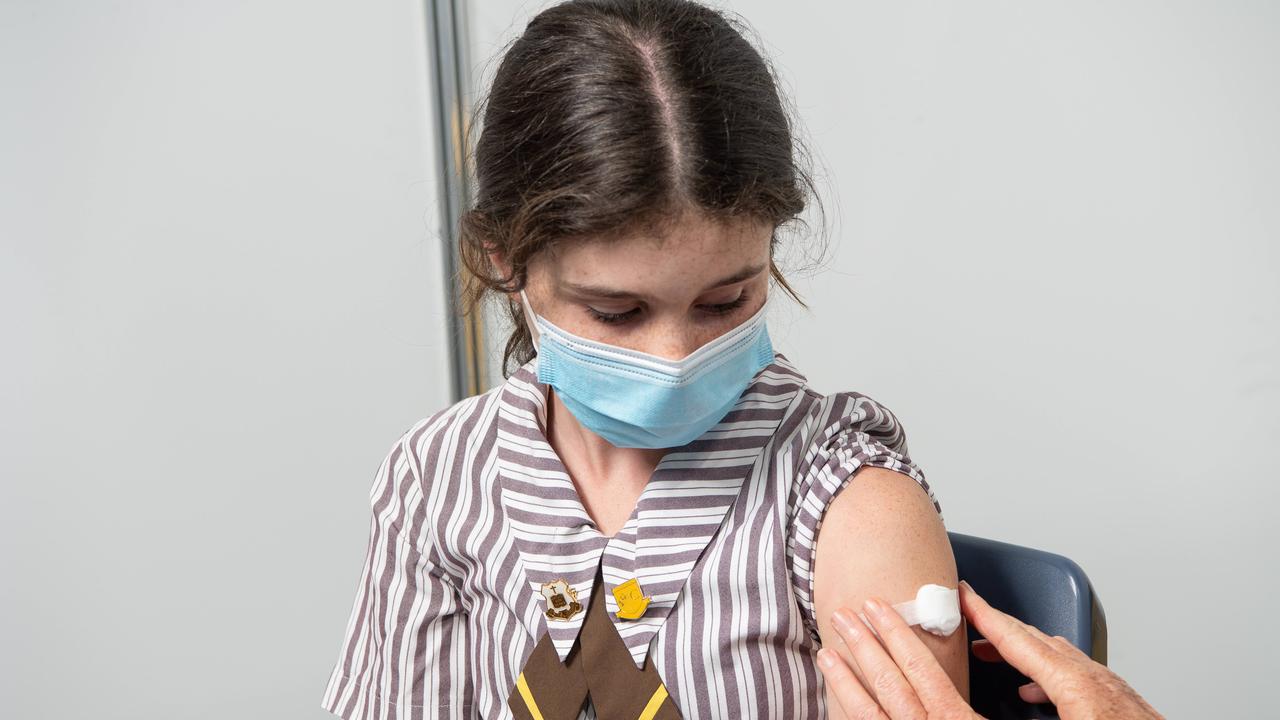Long lockdowns still needed to keep Covid-19 cases down despite vaccinations, new modelling suggests
A new report looking at vaccination rates to figure out exactly what’s needed to end lockdowns has come up with some unexpectedly grim results.
Australians will still need to endure lockdowns for at least half the year even once 80 per cent of adults are fully vaccinated against Covid-19, new modelling has found.
University of Melbourne researchers have released a new report 2022 will be better: COVID-19 Pandemic Tradeoffs modelling that sets out just how difficult it will be for Australia to return to normal life even once a significant proportion of the population is fully vaccinated.
The Federal Government has set a target of getting 80 per cent of adults fully vaccinated, based Doherty Institute modelling, to make lockdowns “pretty much a thing of the past”.
However, the Melbourne University research, which uses the state of Victoria as the modelled population, expects people will still need to be in lockdown for 58 per cent of the year to keep deaths down to 1000 a year (in a jurisdiction with a similar population) and infections to 320 a day.
“This default scenario requires over half the time in lockdown. We have to do better than this,” the report states.
In the scenario, lockdowns were required even though 80 per cent of adults were vaccinated and restrictions were eased to “loose suppression” (somewhere between the measures required to keep cases very low and those required to keep them to a level the health system can tolerate), with a moderate level of infections from vaccinated overseas arrivals who did not have to quarantine.
However, researchers found introducing certain extra measures could make a significant difference and reduce the time spent in lockdowns significantly.

Lockdowns could be brought down to 14 per cent of the year if children as young as five years old were also vaccinated and minimum Stage 2 level of restrictions were maintained, even when case numbers were low. These measures could include people continuing to work from home, keeping hospitality density limits, high levels of mask wearing and not allowing unvaccinated people to gather.
These additional restrictions could see cases in a state the size of Victoria brought down to 64 a day, with an average of 250 deaths a year. Around 960 people would be hospitalised.
The study, led by epidemiologist Professor Tony Blakely, modelled 432 possible scenarios and found that none of them showed the population reaching herd immunity at the end of one year.
“The modelling in this report suggests – at first glance – that life may not be so good in 2022, even at 80 per cent vaccination coverage of both adults and children,” it states.
“However, our policy relevant sensitivity analyses point to many innovations that can ‘make life better’.”
Even once 70 per cent of children and adults are vaccinated it recommends the widespread use of masks indoors and in crowded outdoor environments should continue — even when not in lockdown — to minimise the need for stay-at-home orders.
It also suggests using rapid antigen testing in settings such as schools, workplaces, and other mass gathering sites, as well as improving ventilation in buildings such as schools.
The researchers caution against a major opening up of quarantine-free travel for international arrivals – unless travellers are from low-risk countries such as China — saying it was “not wise” at only 70 per cent vaccination.
“It will take more than what many assume to ‘live with the virus’, but by effectively using the tools we have now and innovating, we can achieve a well-functioning society in 2022,” the report states.
“It is critical to note that it is not the vaccination coverage alone that determines what opening up and 2022 will be like. Rather, it is the full package of measures – of which vaccination coverage is just one measure.”
How we could end lockdowns
Lockdowns would likely not be necessary if Australia is able to get its vaccination coverage up to 90 per cent of adults and children, while maintaining Stage 2 restrictions. This scenario would see just 190 hospitalisations from Covid a year.
Other measures that could improve the amount of time in lockdown include boosting the effectiveness of tracking, tracing, isolation and quarantine through measures such as mass rapid antigen testing or improving Bluetooth enabled apps like the CovidSafe app developed by the Federal Government.
The study found vaccinating people with Pfizer vaccine instead of AstraZeneca would also make a difference because Pfizer is better at stopping transmission (around 60 per cent compared to 80 per cent), while both provided similar levels of protection when it came to preventing serious illness and death.

In some discouraging news for overseas travellers, the modelling also showed the importance of keeping breaches from quarantine as low as possible, as they could lead to an increase in cases even when 80 per cent of adults were vaccinated.
“It may not be as safe as we suppose for infected travellers to return when we already have high infection rates,” the report said.
In general, the research supports a key finding in Doherty Institute modelling — that keeping light restrictions in place at all times dramatically reduces the need for lockdowns.
Keeping a minimum level of restrictions in place rather than allowing people to go back to living “near-normally” dramatically reduced the time in soft or hard lockdowns.
This is because it reduces the yo-yo effect that can emerge when cases spread during times of almost no restrictions, fuelling explosive outbreaks that make it hard for contact tracers to keep up and result in more frequent lockdowns.
Overseas examples show why we should be cautious
The report noted the results in other countries including the United Kingdom, Denmark and Singapore.
It pointed out that Singapore, which has one of the highest rates of vaccination with more than 80 per cent of its total population double dosed, still experienced an increase in cases once it eased restrictions after 70 per cent of its total population was fully vaccinated in August. At the time its seven-day rolling average was less than 100 new cases.
The rise in cases happened despite them maintaining mandatory masks, and restricting indoor dining to those who were fully vaccinated or who were able to provide a negative test result in the previous 24 hours.
Lots of uncertainty around
The Melbourne University report addresses some of the gaps in the Doherty modelling but it also points out data is unclear when it comes to several factors that could make a big difference to results.
This includes uncertainty around how many of those who get Delta are asymptomatic and can spread the disease without knowing, and how effective the vaccines are at stopping vaccinated people from spreading the virus.
For example, the Doherty report assumed vaccination reduces the infection rate by 65 per cent but Melbourne University researchers believes this is too “optimistic” and they used a figure of 25 per cent on average.
“If we replace this with the 65 per cent reduction assumed in the Doherty-led modelling, the situation improves dramatically,” the report says.
Because of this Melbourne researchers believe Doherty could be “overestimating how good 2022 might be”.
The report also assumes Delta has a R0 of 6.5, which means one person can infect around six others, but if this turned out to be higher than this could also increase the impacts.
Another complicating factor is the emerging evidence that both AstraZeneca and Pfizer lose their effectiveness over time against the Delta virus and this may require people to get booster shots to maintain their effectiveness.
However, the report does address some of the criticism around the Doherty modelling, as it looks at the numbers of deaths across a year rather than just six months.
It also analyses what would happen for the next year if Australia were to open up now, while it is going through a period of community transmission, rather than starting from a baseline of 30 cases like Doherty did.
Researchers believe the Melbourne modelling complements other work, like Doherty’s.
“It is best practice for Governments and decision-makers to take a ‘many models’ approach to decision-making support,” the report says.
“If all models give the same answer, the decision-maker has confidence in the action they are about to take.”
The public is able to look at Melbourne University’s modelled scenarios using an interactive webtool at www.pandemictradeoffs.com.






